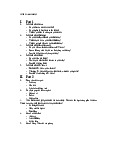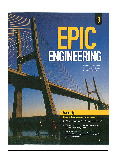













Preview text:
Moving to and within the cloud
The importance of using data lineage and
blueprints to avoid unintended consequences Moving to and within the cloud Moving to and within the cloud Contents 03 Introduction 04 Overview
04 A further note on the CDMC framework
04 When you move to the cloud: a regulatory perspective
05 General considerations to take before moving to the cloud 05 Data lineage
07 Using blueprints for scenario planning, impact analysis and more
07 Blueprints: an overview
07 Reducing risk with robust impact analysis
08 Essential views on your cloud transformation program: ‘as-is’ and ‘to-be’ lineage
09 Data privacy, data sharing and other regulatory responsibilities 09 Business continuity
09 Business opportunities
10 A non-exhaustive checklist 11 Conclusion 12 About Solidatus Moving to and within the cloud Introduction Overview
Take a moment to reflect on the past five years of technological innovation. During that time, it would be hard to find a better or more
universal example of a case of ‘when, not if’ than the issue of moving your business systems to the cloud.
These are just a handful of statistics from a recent Web Tribunal article: $623.3bn 94% 30%
The public cloud service market is expected
94% of enterprises already use a
30% of all IT budgets are to reach $623.3b n by 2023 worldwide cloud service allocated to cloud computing $1.2m 5 100ZB
50% of enterprises spend more than
Organizations leverage almost 5 different
By 2025, the data stored in cloud data
$1.2m on cloud services annually cloud platforms on average
centres will exceed 100 zettabytes*
*(A zettabyte is 1021 bytes. Or, to put it in lay terms, a LOT.) (1ZB = 1bn terabytes)
So, it’s highly likely that you’re already some way there. Few businesses haven’t started the process. Many operate a hybrid model
with their tech straddling the cloud and on-prem servers. But that’s the thing: it’s a process, not an event, and a highly complex,
risky and time-consuming one at that.
You might even call it a discipline – almost in the monastic sense of the word – which, once adopted, demands a continuing daily
obligation in terms of observance and behaviour.
The overriding objective of data management in its broadest sense is optimal support for the business. So, moving data or systems
to the cloud is not a one-off decision but something requiring continual monitoring to ensure that yesterday’s decision is still right
for the business today. To do that in a way that preserves your sanity, you need to understand the entirety of your data estate and
how it maps to your business functions.
There’s also no real end date; even when the bulk of your operations are in the cloud, which cloud is it? There are several to choose
from, all with their strengths and weaknesses, so there’s a good chance you’ll choose more than one. Which of your systems should
go where? How will these systems interact with each other once they’re up in the heavens, and what changes might you have to make down the line?
This is before you look at the ESG imperatives in relation to the environmental footprint of cloud data centres and blockchain,
which is perhaps a story for another day.
None of these questions is easy to answer. And none can be treated in isolation. But they must all be addressed. So, the overarching
question isn’t whether but how.
There are literally thousands of free online resources on the myriad considerations of cloud migration. They address a wide range of
issues, and we’d of course recommend you read some of them.
But in this document, we focus on the under-discussed but highly valuable concept of lineage – for your data, systems
and processes – and, by extension, the idea of data blueprints, all of which ties in with the EDM Council’s CDMC (Cloud Data
Management Capabilities) framework, which we wrote about on our blog. 03 Moving to and within the cloud
That ongoing initiative comprised six major categories:
1 Governance and accountability 4 Protection 2 Cataloguing 5 Data lifecycle 3 Accessibility
6 Data and technical architecture
And from it emerged five objectives for data lineage:
1 To implement automated functionality that identifies
4 To ensure lineage auto-discovery is enabled in hybrid and processes that move data.
multiple cloud environments, and identify data movement between those environments.
2 To record data lineage metadata for data movement
processes that are discovered automatically.
5 To define and implement processes for the review of
auto-discovered lineage information.
3 To ensure lineage auto-discovery identifies processes that
move data across jurisdictions, availability zones and physical boundaries.
As you read this whitepaper, you’ll see how some of these themes dovetail with what we go on to discuss, but there’s much else
to consider, as you’ll discover…
A further note on the CDMC framework
Our blog post provides a good overview of the EDM Council’s lineage recommendations in relation to cloud migration. But if you have
time, it’s worth reading about their full Cloud Data Management Capabilities Framework, a document on which you can download on the EDM Council website.
In particular, Section 6.2 on understanding data provenance and lineage, which runs for several pages from page 143, provides
invaluable advice for data practitioners, complementing our white paper.
Its ‘scoring’ tables in the same section should also be incorporated into your programme of activities.
When you move to the cloud: a regulatory perspective
Before we proceed, it’s worth pausing for a moment to ask what data and systems we always retain, however it is that we move
them to the cloud. We’re not selling the concept, and the technical benefits that serve a dispersing workforce – reliability, scalability,
flexibility, consistent processing – are widely understood. But from data management and governance perspectives, the simple truth
is that most regulators are now in the cloud.
And these regulators are increasingly unwilling to accept infractions in the cloud as the responsibility of the cloud provider, rather than
the client using cloud services. That being so, only a complete understanding of how your cloud usage is arranged can provide an
adequate defence against inadvertent transgression. 04 Moving to and within the cloud
General considerations to take before moving to the cloud
Before embarking on any cloud migration journey, you must:
Understand the key data and systems, and therefore the
Reduce operational risk from extensive manual efforts related
greatest migration risks for your organization.
to data sourcing, standardization and analysis and report production.
Look at data sharing and permissions.
Reduce technology risk and increased operating expenses or
Reflect on change management throughout your migration.
project costs due to redundant sources of data and data silos.
Document your data estate throughout the process.
Improve operational reporting and real-time access to
Demonstrate through lineage documentation and reporting the high-quality data.
control of the relationships with third parties and outsourcing arrangements.
We’ll explore some of these in more depth as we ask the fundamental question: what does ‘good’ look like?
The simple answer is ‘good’ is a complete and genuine understanding of: where your data came from; its journey; where it is now; any
transformations it’s undergone or will undergo; and where it’s going. It all starts with lineage. Data lineage
A central theme of this document is lineage. It weaves its way into every aspect of data and systems management, and, by extension, cloud migration.
The concept of data lineage is very straightforward: it’s simply a description of a piece of data’s journey, one that outlines where it first
came into your organization’s databases and systems, and its stops along the way.
But it gets complicated for several reasons, including:
Changes it undergoes along the way – Mike Turner on your
Split paths that a piece of data takes – linear paths are rarely
company’s Slack account is Michael Turner on the payroll smooth and one-dimensional
Determining whether similar records in different databases
Version control and the ‘temporal’ nature of lineage
relate to the same entity – Mike and Michael are one and
the same, but B. Andrew Brown and Andrew Brown could well be different
And this is before you look at its many possible onwards journeys, some pre-determined, others up for debate.
The larger the organization, and the more complex and diverse its systems, the greater the data lineage headache. When the cloud is
brought into the mix, along with the local data regulations associated with wherever your cloud is hosted, you can safely conclude
that the picture isn’t simplified.
The only way to keep your head is to model your lineage with a software solution that allows you to visualize it and, by applying rules
that you set, isolate specific paths that cut out the noise.
Put simply, a lineage model – such as those you can build in Solidatus (solidatus.com) – is a visualization that shows you the
interplay of data (or other types of ‘objects’ that you map) and the uses to which it is put within a context framed by the modeler.
It’s also worth flagging up a related type of model, one that Solidatus also supports: the reference model. A reference model
provides a hierarchical representation of concepts that can be cross-referenced with entities in lineage models or other reference
models. A lineage model can be linked to one or more reference models describing business terminology, regulatory principles, and more.
This cross-referencing is crucial when considering the jurisdiction point we raise in the overview above. 05 Moving to and within the cloud
Before we move on to the next section, which builds on these ideas, take a look at our cloud data management page, where you can
zoom in on the sample lineage model reproduced here. 06 Moving to and within the cloud
Using blueprints for scenario planning, impact analysis and more
If you’re clear on the principles of data lineage, then scenario planning and impact analysis easily follow as extensions to it.
These twin disciplines can be aided by blueprints. But what do we mean by that term? Blueprints: an overview What is a blueprint?
In the world of construction, a blueprint is a two-dimensional drawing that provides a visual representation of a building’s layout,
dimensions, component placement, electrical wiring and construction materials. Drawn up by architects or engineers, blueprints
allow you to quickly check and identify different building elements and verify compliance with building codes.
A blueprint follows a carefully thought-out, logical sequence of steps. Drawing pages in blueprint sets are arranged in a predictable
fashion, and blueprint symbols and lines have highly specific meanings.
Imagine if instead of a building inspection, you were required to undergo a business inspection.
Could you visually lay out the dimensions and components that inform your business decisions and drive your operations?
Are you confident that you have structural integrity, and that your data governance and management capabilities provide the
appropriate level of safety and soundness required to verify compliance with regulatory obligations, reporting requirements and privacy standards?
Traditional lineage approaches can be daunting for any organization. Having to source and then document the sources of
information that describe the processes, people, systems, data, reports and controls seems unattainable. Especially considering
that everything that needs to be documented has likely never been documented.
With the right lineage software solution, you can ingest metadata across key systems, providing a view of the federated collection
and documentation of key processes that drive your business.
Put simply, a blueprint – in the context of data management generally and cloud migration specifically – is an interactive, living
visualization of how your data flows and its connection to the obligations that regulate it, your policies that guide it and your
processes that create or use it – both now and at other points in time.
Reducing risk with robust impact analysis
The value of a good blueprint extends far beyond regulatory reporting and controls, though we’ll touch on these later in this chapter.
The business benefits associated with the ability to conduct a thorough impact analysis as part of major transformation programs are significant.
To maximise efficiency and avoid unintended consequences, this is hugely applicable to cloud migrations and the phased approach
that you’re likely to take – or are already undertaking.
With access to the right software, you can see the magnitude and scope of downstream impacts of moving to or within the cloud
– and it’s of course much cheaper to assess these multiple, bitemporal ‘what if’ scenarios before they potentially impact your business than after.
The insights and intelligence from having this landscape view, and in understanding the level of interconnectedness of your
applications and data repositories, will enable you to budget appropriately and plan accordingly – accelerating your program
timelines by making the ‘unknown known’ much more quickly than traditional current state assessments. 07 Moving to and within the cloud
Essential views on your cloud transformation program: ‘as-is’ and ‘to-be’ lineage
One of the advantages of having data lineage visualized is being able to see the impacts of changes to data architecture. Imagine that
we work for a company that plans to migrate data housed in multiple on-prem systems to the cloud. Specifically, we’re concerned
with our credit card (Vision+) system and our four mortgage systems. Each feeds into a landing area, a data lake and a series of other
systems, but in this case, we are only concerned with investigating the impact of migrating our on-prem source system to the cloud.
Several variables are of interest: cost, staff numbers, system ratings and service level agreements (SLAs). Below is a view of our ‘as-is’ data lineage.
Let’s produce a view for our ‘to-be’ data lineage. By creating the layer titled: Source System Cloud, we can explore and compare our
variables of interest against our current on-prem source system.
Using a tool like Solidatus, we can create a series of display rules that enables a user to illuminate parts of a model in order to
highlight entities and expose additional metadata to enhance the user’s view of that model.
Here’s an example of a ‘to-be’ view:
You can read more about using display rules and variables to create different views on our website.
To reiterate, the crucial point is that it’s far better to understand and then migrate than it is to migrate and then try to understand;
decisions must be scientifically informed, not based on gut feel or, worse, ignorance.
We’ve looked at the how of impact analysis. Let’s take a look at the why, or at least some of the key reasons. 08 Moving to and within the cloud
Data privacy, data sharing and other regulatory responsibilities
While this white paper doesn’t focus or dwell on regulations, it goes without saying that you must include them in your plans
when migrating to the cloud; and a lineage-based approach will help you keep track of what you need to consider vis-à-vis local
regulations for wherever your cloud servers are hosted.
When it comes to reporting your activity, we should note that a regulator wouldn’t ask for information that shouldn’t already be
known to the business, for business as opposed to regulatory purposes.
It all comes back to using blueprints for better decision-making and leveraging of expenditure to improve business data in
pursuit of accurate regulatory submissions. If you get this right, your regulatory reporting will follow much more easily.
Which brings us on to the next two sections, which go hand-in-hand: business continuity and business opportunities. Business continuity
Businesses operate like flywheels. They must keep turning. To ensure business continuity, a data lineage and blueprint approach
will – among a great many other things – help you:
Establish mission-critical and non-mission-critical systems,
Preserve the necessary elements of your legacy systems.
helping you prioritise your road map.
Plan for disaster recovery; and
Minimize the number and frequency of migrations you have to do.
Keep your cybersecurity systems in check. Minimising downtime.
But it’s not just about reducing risk; it’s about creating opportunities, something that a well-thought-through lineage-based approach
to cloud migration will promote. Business opportunities
With a well-defined blueprint, you’ll save time and money in your cloud migration planning. But this almost goes without saying.
Let’s take a very quick look at some of the other business opportunities of this approach.
Reducing time and costs is dependent on increased efficiency
As we also said earlier, this approach facilitates more
– a lineage-based approach to cloud migration will eliminate
proactive data governance, which will reduce tail-chasing
redundancy with its attendant overheads.
when the regulators come knocking.
It will also reveal cross-selling opportunities, meaning you
In its broadest application, you’ll increase your data
can optimize your client relationships.
discovery, which unearths numerous secondary operational and business benefits.
Enterprise-wide pattern appreciation is elevated, bringing
with it opportunities in the artificial intelligence and machine
Perhaps above all – though at the end of this list! – this learning space.
blueprint approach to cloud migration will help your
organization foster a better data culture, which will permeate
From a business perspective, you’ll almost certainly want to your whole business.
phase your migration to the cloud; this approach will help you
optimize this phasing, as we touch on in the impact analysis section above.
As there are some commercial implications for spreading
across more than one cloud or more than one cloud
provider, this must be factored into your planning,
something that’s aided by a lineage-first approach
– see Cloud Data Management Capabilities Framework, as mentioned earlier. 09 Moving to and within the cloud
A non-exhaustive checklist
We’ve covered a lot of ground but before we conclude by reiterating some of the benefits of a lineage-first, blueprint-based approach
to cloud migration, let’s lay out a non-exhaustive checklist of the main points to consider or steps to take before diving into any cloud
migration project with reference to a software solution that can help these activities. Map your data, processes Map the people you need Set up rules within your Add rich metadata so that and systems in a lineage to work on your migration model so that you can you can create a fuller model or models.* project(s), not just the isolate work stream-
picture of your ‘as-is’ view data and systems. related views. and ‘to-be’ scenarios. Create reference models, Review your work with Explore these various which can be cross- your team through the scenarios as part of a referenced with and linked to visualisations that your thorough program of your lineage models, for a models offer. impact analysis. deeper understanding.
You should also review the data lineage controls laid out on the last page of Cloud Data Management Capabilities Framework, which include:
Risks addressed: 'Data cannot be determined as having
Legacy and on-prem challenges: 'Lineage information is
originated from an authoritative source resulting in a lack of
produced manually by tracing the flow of data through systems
trust of the data, inability to meet regulatory requirements, and
from source to consumption. The cost of this approach and the
inefficiencies in the organization’s system architecture'.
consequences of producing incorrect data can be significant'.
Using the right software can help reduce this manual pain.
Drivers and requirements: 'Organizations need to trust data
being used and confirm that it is being sourced in a controlled
manner. Regulated organizations produce lineage information
as evidence that the information on regulatory reports has been
taken from an authoritative source for that type of data.'
Above all, foster a more collaborative data management culture. If you can articulate convincingly to your colleagues that data
management is just a form of business management, it will be hard for them to refuse to collaborate. This means helping them
clearly visualize business interdependencies.
*Hopefully, you won’t be starting from scratch, as these are used for efficient data management and governance well beyond the world of cloud migrations. 10 Moving to and within the cloud Conclusion
By way of conclusion, let’s simply consider the benefits that the right software can bring to your cloud-migration endeavours.
Building a complete cloud migration strategy
With the right data lineage solution, you can experiment on a linked snapshot of the current view and assess the impact of making
changes as regulations evolve, and as new data sources and organizations come online, preventing data duplication and wasted resources. Protecting your reputation
Mitigate the significant reputational risks associated with a data breach and avoid regulatory fines and sanctions by mapping data
privacy, access and retention rules across all your business entities, jurisdictions, data categories, usages and systems – delivering
major time savings and efficiency increases.
Maintaining a diverse cloud-services architecture
Lineage-first technology enables you to dynamically connect and visualize complex data relationships, break down silos, and avoid
vendor lock-in and ensure compliance, which is particularly important if you’re responsible for a global organization with multi-cloud data infrastructures.
Collaborative data management
The right software allows data management to be distributed, federated and democratized. You can enable subject matter experts
to discover, document, validate and disseminate information and expertise, while unlocking actionable insights behind data.
Transforming your organization
Use initial investment in cloud transformation to deliver a 360° view across your organization to elevate and transform its data
capabilities, improving data management and governance to increase revenue streams. 11 Moving to and within the cloud About Solidatus Overview
Solidatus is an innovative data management solution that empowers organizations to connect and visualize their data relationships,
simplifying how they identify, access and understand them. With a sustainable data foundation in place, data-rich enterprises can
meet regulatory requirements, drive digital transformation, capture business insights and make better, less risky and more informed data-driven decisions.
Solidatus’ powerful metadata management technology is seen as a critical development in data management software – one that
matches the complex needs of modern business. Launched in 2017, Solidatus is the chosen data management tool for both the
regulators and the regulated. Its clients and investors include top-tier global financial services brands such as Citi and HSBC,
healthcare and retail organizations as well as government institutions. For more information, visit solidatus.com.
In relation to cloud migration, Solidatus enables you to:
Capture both technical and business data lineage to foster
Connect the dots on disparate pieces of reporting and
an understanding based on a common language
analysis, and formulate a cohesive understanding of your business performance drivers
Conduct scenario planning and impact analysis to more
accurately quantify impacts to your upstream and/or
downstream processes, applications and data flow Request a demo
We’d love to show you how Solidatus can benefit you.
Sign up for a demo on our website at solidatus.com or email us on hello@solidatus.com. 12
© 2022 – Threadneedle Software Holdings Limited. Solidatus is a registered trademark of Threadneedle Software Holdings Limited solidatus.com




